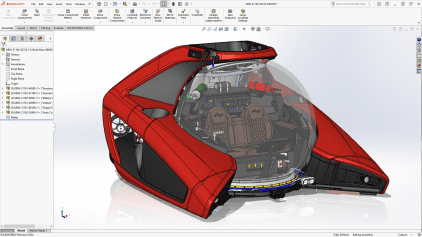For a long time, Product Data Management (PDM) for SolidWorks meant one thing: a heavy on-premise vault, a Windows client, and a long list of rules everyone was supposed to follow.
That model was built for a different era – when all engineers sat in the same office, VPNs were rare, and IT could babysit a local server. Today, most engineering organizations look very different: distributed SolidWorks teams, outside contractors and suppliers, and management pushing for faster releases with fewer errors.
This is precisely why cloud-based PDM has become a serious alternative to traditional SolidWorks PDM. Instead of “just another server”, it offers a managed, web-centric platform that still enforces discipline around CAD data – but without the operational drag.
In this article, we will look at:
• why legacy on-premise SolidWorks PDM is hitting a wall;
• what cloud-based PDM really changes in everyday SolidWorks work;
• how specialist tools like Sibe’s cloud-based PDM fit into this shift;
• and what experienced PDM admins have learned from 10–15 years of running vaults.
Why Traditional On-Premise SolidWorks PDM Is Hitting a Wall
Talk to any SolidWorks PDM admin who has been maintaining a vault for a decade or more, and you will hear the same themes again and again.
1. Remote work and VPN bottlenecks
Classic SolidWorks PDM was designed when “the office” was the default. Once teams go hybrid or remote, simple actions like “open a large assembly from home” turn into:
• connect to a VPN;
• hope the tunnel stays stable for hundreds of megabytes of CAD data;
• wait through frequent pauses, opening, checking in, and checking out.
For large SolidWorks assemblies, that latency doesn’t just irritate people—it directly increases cycle times and slows collaboration.
2. High IT overhead and upgrade fatigue
On-premise PDM brings a lot of hidden costs:
• dedicated servers and storage;
• regular patching, monitoring, and backups;
• planning and testing for every major upgrade.
Many companies end up “freezing” their PDM at a comfortable version because upgrades feel risky or disruptive. That, in turn, creates compatibility headaches when newer SolidWorks versions are rolled out on the desktop.
3. Complex rules engineers work around
PDM is only as strong as day-to-day habits. In the real world, power users and new hires alike end up:
• editing parts outside the vault “just this once”;
• keeping local copies on desktops or shared drives;
• forgetting state names, revision rules, or approval steps.
Once that happens, the whole idea of a single source of truth breaks down – even if the vault itself is technically working.
4. Poor visibility for non-CAD stakeholders
Legacy PDM is typically built for CAD experts, not for the wider organization. Project managers, quality, procurement, and external partners:
• have no access at all; or
• need a full Windows client, they rarely use.
This makes it harder to build a connected digital thread from design to manufacturing and beyond.
What Cloud-Based PDM Really Means for SolidWorks Teams
“Cloud PDM” is not just “PDM in a browser”. When done correctly, it changes the underlying operating model for engineering data.
1. Location-independent, internet-native access
Instead of tunneling into a single office server, engineers use a cloud platform designed for regular internet connections. For SolidWorks teams, that often means:
• more predictable performance for remote and hybrid engineers;
• simpler collaboration with contractors and suppliers in other regions;
• reduced dependence on a specific office or network.
In practice, this means your best designers no longer lose hours each week fighting VPNs and slow file operations.
2. Managed service instead of local infrastructure
Cloud-based PDM follows a managed SaaS model:
• no local PDM servers to size, patch, or backup;
• application and security updates handled centrally;
• new capabilities rolled out without complete “PDM upgrade projects”.
IT and PDM admins shift from “keeping the vault alive” to “designing better processes and data structures”.
3. A single source of truth that’s actually used
A well-designed SolidWorks cloud PDM still enforces:
• proper version and revision control;
• traceable histories of who changed what and when;
• configurable workflows and approvals.
The difference is that the experience can be simpler and more discoverable, so engineers are far more likely to follow the process ratherthan work around it.
What SolidWorks Engineers Expect From Modern Cloud PDM
If you ask experienced SolidWorks users what they want from cloud PDM, the answer is rarely “more features”. It’s usually much simpler.
Fast, predictable check-in and check-out
SolidWorks users will stick to the process if:
• check-in/check-out is fast, even for large assemblies;
• references and dependencies are resolved automatically;
• There is no constant risk of breaking someone else’s work.
Cloud PDM,explicitlydesigned for SolidWorks, can optimize for these flows instead of treating CAD data like generic office documents.
Better part reuse and moreintelligent search
After years of projects, most teams end up with:
• slight variations of the same part;
• duplicated models under different names;
• assemblies that are hard for new engineers to navigate.
Modern cloud-based PDM for SolidWorks focuses heavily on search and classification – helping engineers find and reuse what they already have instead of starting from scratch.
Realistic, visible approval processes
Mature teams treat engineering data as part of a controlled lifecycle, not just files in folders. Cloud PDM that supports this:
• offers configurable workflows for review and release;
• aligns with existing revision schemes and naming rules;
• makes it obvious which versions are “in work” vs. “released”.
The result is fewer surprises when data moves into manufacturing, quality, or customer-facing documentation.
Sibe PDM: A Cloud PDM Built Specifically for SolidWorks Teams
Sibe PDM is a modern, purpose-built cloud PDM for SolidWorks teams. Instead of trying to be a generic document system, it focuses on the patterns SolidWorks engineers and PDM admins have been dealing with for 10–15 years.
From a functional standpoint, Sibe PDM:
• treats assemblies, parts, drawings, and their references as first-class citizens;
• streamlines SolidWorks check-in and check-out, including reference management;
• provides a web interface that non-CAD stakeholders can use to see accurate, up-to-date data.
From an operational standpoint, Sibe PDM aims to remove the friction that often blocks PDM adoption:
• cloud-native rollout measured in days, not months;
• no dedicated on-prem PDM server to purchase and maintain;
• straightforward pricing that makes sense for small and mid-sized manufacturers.
For SolidWorks teams that already understand the value of PDM but are stuck on a legacy vault, this kind of SolidWorks PDM alternative can be a natural next step.
If you want to explore such a platform in more detail, you can take a closer look at Sibe PDM cloud PDM for SolidWorks teams and its approach to modern engineering data management.
How to Migrate From Legacy SolidWorks PDM to Cloud Without Chaos
Even when teams are convinced of the benefits of cloud-based PDM, one big question remains: how do we move without breaking everything?
Experienced PDM admins usually follow a staged, low-risk plan.
Step 1 – Audit and clean your data
Before moving anything, teams:
• identify active projects vs. long-term archives;
• document current folder structures and naming conventions;
• remove obvious duplicates and obsolete data where possible.
This prevents you from importing years of clutter into the new cloud PDM.
Step 2 – Map structures, states, and metadata
Next, admins define how today’s:
• folders;
• lifecycle states;
• revision schemes;
• custom properties and metadata
Should map into the new cloud-based PDM for SolidWorks. This is a good moment to simplify workflows that have grown overly complex.
Step 3 – Run a real-world pilot
A single live project is migrated first, with a small group of SolidWorks users:
• real assemblies and drawings, not dummy data;
• fast feedback loops between engineers and the PDM admin;
• quick adjustments to permissions, states, or workflows where needed.
The goal here is to validate that the cloud PDM aligns with how the team actually works, not with how the process looked on a whiteboard years ago.
Step 4 – Scale out to the full vault
Only after a successful pilot do teams:
• migrate other active projects;
• provide short, focused training and cheatsheets;
• update onboarding materials for new engineers.
Because the platform is cloud-based, rollout is much simpler than traditional PDM upgrades – there is no need to push new clients or coordinate complex server changes.
Lessons From 15+ Years of SolidWorks PDM Practice
Across industries and company sizes, long-time SolidWorks PDM admins tend to agree on a few simple principles:
• Tools follow culture. PDM – cloud or on-prem – only works if the team agrees that the vault is the single source of truth. Parallel folder structures and “shadow libraries” will always cause trouble.
• Start simple, then evolve. A straightforward, minimal workflow implemented in cloud PDM is more effective than a complex state machine that nobody remembers. It’s easier to add sophistication than to roll back complexity.
• Invest in an internal champion. Adoption goes moresmoothly when at least one respected SolidWorks power userserves as a bridge between everyday design work and PDM configuration.
• Include non-CAD roles from day one. The more easily project managers, purchasing, and quality can see accurate data, the fewer manual exports, screenshots, and “can you send me the latest drawing?” emails the team needs.
Cloud-based PDM does not magically fix bad processes – but it removes much of the technical friction that has made good processes hard to sustain.
FAQ: Cloud PDM for SolidWorks – Common Questions Answered
Is cloud PDM secure enough for sensitive manufacturing data?
Modern cloud-based PDM platforms use encryption in transit and at rest, strict access control, audit logs, and managed backups. For many small and mid-sized manufacturers, this is actually an improvement over a single on-prem server that depends on one or two overworked IT admins.
How does cloud PDM handle large SolidWorks assemblies?
Engineering-focused cloud PDM systems are optimized for typical SolidWorks usage—working with assemblies, sub-assemblies, and drawings that share many references. Smart caching, incremental operations, and reference-aware check-in/check-out help keep performance predictable, even over internet connections.
Do we have to change all our revision rules and naming schemes?
Not necessarily. Most cloud PDM platforms let you keep existing revision schemes and naming standards, while also giving you a chance to simplify. Many teams treat migration as an opportunity to remove legacy complexities that nobody can justify anymore.
Is cloud PDM only for fully remote teams?
No. Hybrid teams with one or more offices often see the mostsignificant benefit: local engineers have easier access when they travel or work from home. Atthesametime, contractors and suppliers can collaborate without a VPN or a thick client.
Conclusion: Choosing the Right PDM Future for SolidWorks Teams
For modern SolidWorks teams, the question is less “do we need PDM?” and more “which PDM model fits the way we actually work?”.
On-premises SolidWorks PDM still has a place for everything to happen in one secure facility, where IT can fully own the vault. But for many engineering organizations – hybrid teams, multi-site collaboration, rapid product iteration – a specialist cloud-based PDM has become the more practical, sustainable choice.
Platforms like Sibe’s cloud PDM for SolidWorks teams show what this future can look like: a managed, cloud-native environment that keeps engineering data controlled and traceable without forcing engineers or IT to fight the system.































